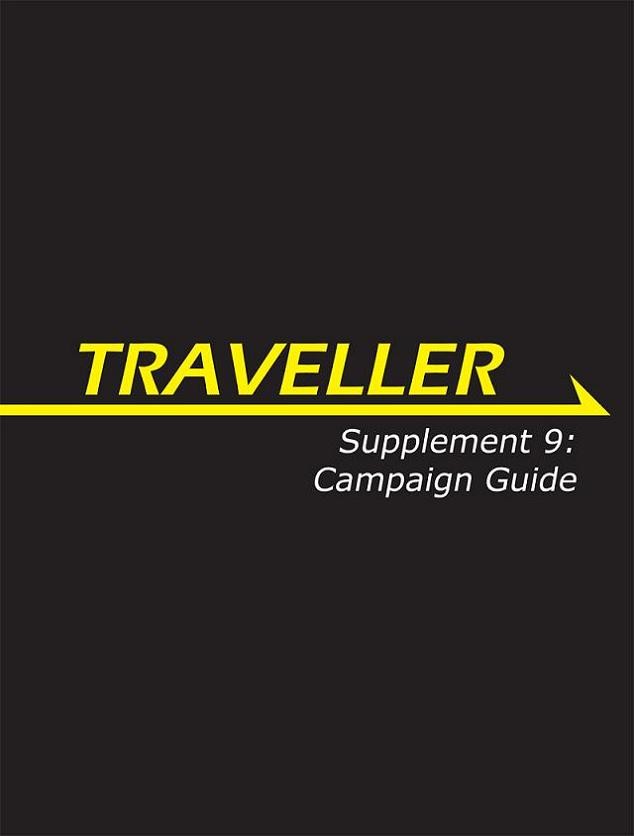Mongoose Traveller Supplement 9: Campaign Guide
This article originally appeared in the April 2012 issue of Freelance Traveller Magazine
 Mongoose
Traveller Supplement 9: Campaign Guide. Uri Kurlianchik.
Mongoose
Traveller Supplement 9: Campaign Guide. Uri Kurlianchik.
Mongoose Publishing http://mongoosepublishing.com
176pp, hardcover
US$34.99/UKú24.99
This long-awaited supplement has its strengths and weaknesses, and is both more and less that what was hoped.
On the Shelf
As a core supplement, not tied to any particular setting, this volume sports the usual solid black cover, with the Traveller name and the arrow in yellow. The tagline is “A Referee’s Essential Lifeline”.
Initial Impressions
A neatly-organized volume presents the user with plenty of tables, and a good amount of explicatory text. Artwork is sparse and monochrome, appearing to have been from originals that were inks, pencils, or watercolors. Each chapter has a definite and useful focus, though the rationale for the order doesn’t immediately jump out at the reader.
On Closer Inspection
Before anything else, it must be made clear that this volume is for referees, not for players. The player who reads it won’t be “spoiled” for adventures generated using it, but nothing in it strengthens the player’s ability to play his/her character, or to develop the character beyond a set of stats and skills.
The introduction and first chapter set the tone and expectations for the rest of the book; rather than summarizing philosophical discussion of running a campaign, or practical adventure management techniques, it sets out an outline of an “Automatic Adventure”, conforming to a generalized structure, and suitable for quick die-roll-based generation of details. The remaining chapters each flesh out an aspect of the automatic generation process.
There are chapters for generating events in space and on worlds, for “life events” (similar to those in the core character generation rules), and plot hooks (which can be used as alternative starting points for adventures). This brings the referee to the halfway point in the book, and covers the basics. At this point, I remind the reader that Mongoose Traveller is being positioned as a generic SF role-playing system, not strictly “Crunchy Space Opera”, nor tied to a specific setting. This is visible in some of the tables and discussion, which end up including such things as zombies and sentient viruses.
I implied earlier in this review that there was no discussion of practical adventure management techniques; this isn’t quite correct: the second half of the book begins with a chapter on campaign generation that discusses (somewhat superficially) some of the considerations that a referee needs to account for when developing his adventure. The focus here is on making the adventure internally coherent—that is, on relating the various parts of the adventure to each other and to the player-characters so that it isn’t clearly a set of randomly generated encounters presented in sequence. Some consideration of timed adventures, cinematism vs. realism, and static (all significant events are PC-triggered) vs. dynamic (events happen regardless of PC action) adventures is also present in this chapter.
An important consideration in an adventure is world-building; a well-built world has enough detail to be more than merely a stage with flats set up to provide a backdrop for the PCs’ actions. The following chapter discusses world-building, including deciding just how much detail, and over what area, is needed to support the adventure. An important piece of advice that this section gives can’t be emphasized enough: Don’t overdo it—build only what you’re going to need, but build it well. It also provides guidelines (and some random generation tables) for building everything from individual “infrastructure” (buildings or facilities such as hospitals, temples, and starports) to laws, ethnic neighborhoods, power groups ranging from crime syndicates to dominant businesses to political parties to… just about anything. One might consider the World Builders’ Handbook from Digest Group Publications to be the MegaTraveller-era “gold standard” for this sort of thing; this section carries that standard to a new level, directly impacting the PCs.
A chapter on Investigation is written with a principle focus on supporting murder-mystery adventures, but there’s no reason that the material here couldn’t be used to support other sorts of adventures where the PCs must figure out what happened in the past, criminal or not.
The next chapter is a set of tables for generating random events; these are at a “lower” level than the tables used in the first half of the book for fleshing out the structural outline of the adventure, and can actually bring the area of world-building to life, as many of the events need not have anything to do with the adventure’s “story”.
The sample maps of the next chapter are disappointing; none of them are particularly exciting or interesting, and none of them have any scale or grid for use with miniatures.
The appendix has a good number of examples of pre-built locations, significant personages, general NPCs, objects, and answers to questions that might come up in the course of the adventure, even if they’re not actually significant to the adventure.
A useful section that is completely missing from this volume is an index—being able to look up specific subsections for specific purposes would make the volume more useful, even to experienced referees who only need the kind of tools presented here when responding to the unexpected actions of the PCs.
Conclusion
How a reader feels about this volume will depend on what expectations were held before it came out. It’s hard to get enthusiastic about it, but the referee that is seeking a tool to mine for idea nuggets can find some here. On the other hand, the referee or prospective referee seeking discussion of techniques relevant to running an adventure should look elsewhere; this is not the product to find them in. For what it does, it’s a good solid book, and worth the purchase price, but temper your expectations.
 Freelance
Traveller
Freelance
Traveller